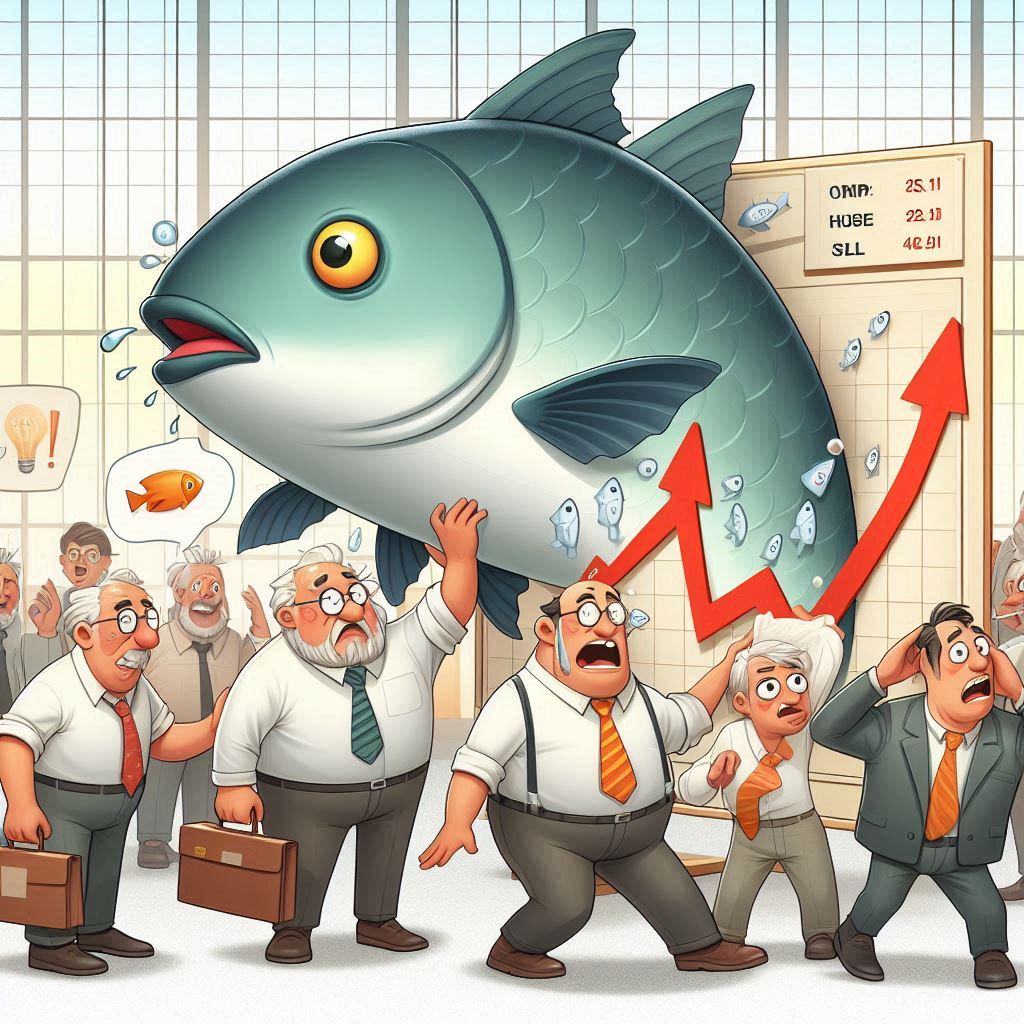The Power of Short Sellers: How It Impacts Stock Prices

The Power of Short Sellers: How It Impacts Stock Prices
Disclaimer: This article is for informational purposes only and should not be considered financial advice. Consult a qualified financial advisor before making financial decisions.
When you hear about stocks taking a dive or companies experiencing significant drops in value, you may wonder what caused it. One major factor could be the action of short sellers, a group of investors betting against the stock price. But how exactly does short selling work, and how does it affect a stock’s value? Let’s dive into it.
Hollywood’s Take on Short Selling
Short selling has been a central theme in several movies that highlight financial crises and trading strategies. The Big Short (2015) is one of the most well-known films, showcasing how investors shorted the housing market before the 2008 financial crash. Another great example is Margin Call (2011), which gives a behind-the-scenes look at Wall Street firms navigating financial turmoil. These movies provide insights into how short selling can expose weaknesses in the market.
What is Short Selling?
Short selling is a trading strategy where an investor borrows shares of a stock they don’t own from a broker and sells them on the open market, hoping the price will fall. The investor’s goal is to buy the shares back at a lower price, return the borrowed shares, and pocket the difference. For example, if an investor borrows shares at $100, sells them, and later buys them back for $80, they’ve made a $20 profit per share.
While it sounds simple, short selling is risky because if the stock price rises instead of falling, the investor can face unlimited losses. This is because there’s theoretically no cap on how high the stock price can go, but there’s a limit to how low it can fall.
What Happened with GameStop?
The GameStop saga, which peaked in early 2021, revolved around a group of retail investors on Reddit’s WallStreetBets forum targeting heavily shorted stocks, with GameStop being the main focus. Institutional investors had bet massively against GameStop’s stock through short selling, which essentially meant they were borrowing shares from brokers to sell them, hoping the stock price would drop.
Why Did Short Sellers Bet Against GameStop?
GameStop, a brick-and-mortar video game retailer, was struggling due to the shift to digital games and the impact of the pandemic on physical stores. Major institutional investors, like Melvin Capital, took large short positions, betting that GameStop’s stock would continue to decline. At the peak, more than 100% of GameStop’s available shares were sold short—this is a highly risky bet because it implies more shares were borrowed than existed in the market!
The Short Squeeze
What happened next was a short squeeze. Retail investors, armed with the knowledge of how heavily shorted GameStop was, began buying up shares en masse, causing the stock price to soar. As the price rose, short sellers were forced to buy back the shares to cover their positions, which further drove the price up, creating a feedback loop. GameStop’s stock price skyrocketed, hitting an all-time high of $483 in January 2021, while institutional short sellers took massive losses.
What Happened After GameStop’s $500 Peak?
After GameStop’s stock price hit nearly $500 per share in January 2021, the price began to rapidly decline due to several factors:
- The Burst of the Short Squeeze: Once the retail investors on r/WallStreetBets saw how heavily shorted GameStop was, they began buying up shares in large quantities. This caused the stock to skyrocket. However, the rise was unsustainable, and after the short squeeze, the stock price plummeted.
- Fading Hype: As the initial excitement around the stock started to fade, the speculative nature of the price surge became more evident. There were no fundamental business improvements to support such high valuations, leading to a sharp price correction.
- Market Volatility and Regulatory Attention: Regulators like the SEC began to pay closer attention to the volatility in the stock market, particularly related to the role of social media and retail trading. This increase in scrutiny, combined with growing concerns, led to a decline in the stock’s value.
- Institutional Influence and Investor Sentiment: Institutional investors, who had been forced to cover their positions during the short squeeze, began selling off their shares. This, coupled with a shift in retail sentiment, caused the price to drop even further.
By February 2021, GameStop’s price had dropped significantly, with the stock falling to around $40 per share by March 2021. It continued to experience volatility throughout the year, reaching a lower stability by early 2025 at about $24.48 per share.
Short Sellers in “Magnificent 7” Stocks
The “Magnificent 7” refers to the top tech stocks—Apple, Microsoft, Alphabet (Google), Amazon, Nvidia, Tesla, and Meta (formerly Facebook)—that have dominated the market in recent years. Short selling these stocks can be dangerous due to their large market caps and consistent growth, but it happens.
Recent Examples of Short Interest on Tech Giants:
- Tesla: Tesla has frequently been a target for short sellers due to its volatile stock price and skepticism about its future. Despite this, Tesla has shown incredible growth, causing significant losses for those betting against it.
- Meta (Facebook): Meta’s stock has seen periods of significant short interest, especially during times when there were doubts about its shift towards the “metaverse.” However, despite these concerns, Meta’s stock has recovered.
Short Interest Ratios for Leading Stocks:
- Nvidia (NVDA): Short interest ratio is 0.7 days.
- Meta Platforms (META): Short interest ratio is 0.5 days.
- Alphabet (GOOGL): Short interest ratio is 0.4 days.
- Amazon (AMZN): Short interest ratio is 0.6 days.
- Microsoft (MSFT): Short interest ratio is 0.3 days.
- Apple (AAPL): Short interest ratio is 0.2 days.
- Tesla (TSLA): Short interest ratio is 0.8 days.
Short selling these high-growth stocks is tricky because they’re prone to volatility, and betting against them often results in painful short squeezes. In fact, Elon Musk’s Twitter comments and other high-profile influencers can cause massive swings in stock prices, catching short sellers off guard.
How Can We Tell If There Are Short Sellers Involved?
- Short Interest Ratio: You can check the short interest ratio, which is the percentage of shares that have been sold short but not yet covered. A high short interest ratio indicates a significant number of investors betting against the stock.
- Days to Cover: This refers to how long it would take for all short sellers to cover their positions if they all tried to buy back shares at once. If this number is high, it suggests that if the stock price rises, there could be a rush to cover, potentially causing a short squeeze.
- Stock Borrowing Fees: Some brokers publish fees associated with borrowing stocks for short selling. If borrowing a stock is expensive, it indicates strong demand from short sellers.
- Look for Unusual Price Movements: Significant price spikes or drops that don’t correlate with news or earnings reports could indicate that short sellers are either exiting their positions or doubling down on a losing bet.
How Does Short Selling Impact Stock Prices?
- Immediate Downward Pressure on Stock Prices
When short sellers enter the market, they’re essentially increasing the supply of shares available for sale. The act of selling borrowed shares creates downward pressure on the stock price. Imagine a lot of investors trying to sell a stock at once, which can create an imbalance in supply and demand—this can cause the stock price to dip.
For companies with high short interest (the percentage of shares being shorted), the stock price could be more sensitive to these downward forces. When short sellers sell off shares, the price may struggle to rise and could even begin to decline, especially if other investors start to follow suit.
- Short Squeeze: The Risk of Rebound
While short sellers bet on a stock’s decline, there’s a risk of a “short squeeze.” This happens when the stock price unexpectedly rises, forcing short sellers to buy back the shares they borrowed to minimize their losses. As short sellers scramble to cover their positions, it creates even more demand for the stock, pushing the price higher.
A short squeeze can cause a stock to skyrocket in a short period of time. One of the most famous examples is the GameStop saga in early 2021, where a massive short squeeze led to an astronomical rise in the stock price, catching many institutional short sellers off guard.
- Market Sentiment and Perception
The more short interest a stock has, the more it may signal to the market that investors believe the stock will decline in value. This perception can influence the behavior of other traders and investors. If people see that short interest is high, they might interpret this as a sign that insiders or sophisticated investors foresee trouble ahead for the company, which can lead to a decrease in demand and push the stock lower.
On the flip side, if a stock with high short interest begins to rise or show signs of improvement, it can generate positive sentiment as traders may anticipate that the short squeeze could take hold. This could attract additional buying interest, leading to a rally.
- Increased Volatility
Short selling increases the volatility of a stock because it can create rapid price movements in both directions. If a stock is heavily shorted, even a small positive development (like an earnings beat or an unexpected piece of news) can lead to a sharp rise in price as short sellers are forced to cover their positions. This can be a double-edged sword for investors, as it creates more risk and uncertainty in the market.
The Use of Put Options as Part of the Strategy
In addition to traditional short selling, investors can use put options as a strategy to bet against a stock. A put option gives the investor the right, but not the obligation, to sell shares at a predetermined price within a set time period. This can be used as a more controlled way of profiting from a potential drop in stock prices. However, buying puts is not without its risks.
While buying puts limits the maximum loss to the cost of the option premium, it’s important to remember that options expire, meaning time works against the investor. Additionally, individual investors need to exercise caution in this strategy due to the complexity and the need for precise timing. Many may opt for buying puts in volatile stocks like Tesla or Meta.
Conclusion
Short selling is a powerful strategy used by investors to profit from declining stock prices, but it comes with significant risks. A short squeeze, which occurs when a heavily shorted stock suddenly rises in price, can cause massive losses for short sellers. As seen in the GameStop incident, short selling can also be highly volatile, leading to extreme price fluctuations. While short interest ratios and market sentiment can provide some insight into the potential for short selling, investors must exercise caution when betting against stocks, especially those with high short interest.
If you’re an investor considering short selling, it’s essential to understand the dynamics of short interest, the potential risks, and the tools available for managing those risks. Whether you’re targeting stocks in the tech sector or individual companies, always do your due diligence, stay updated on market trends, and never underestimate the power of short squeezes.



0 Comments